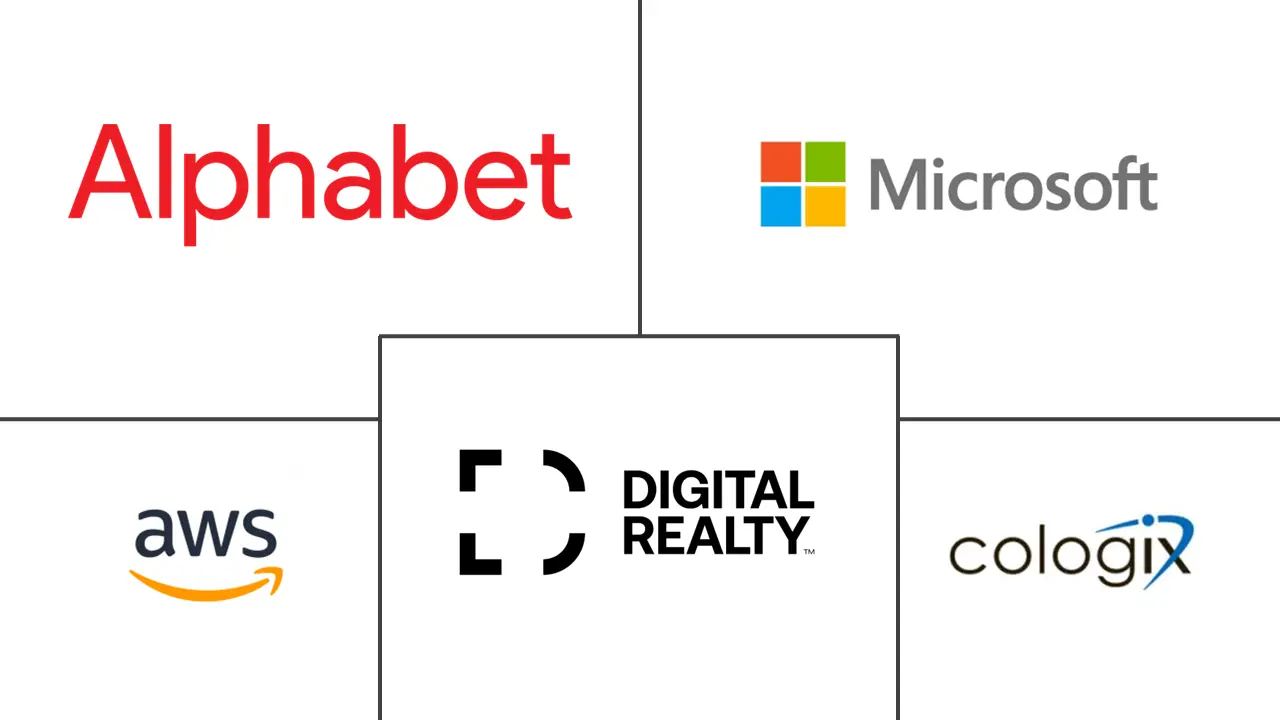Canada Hyperscale Data Center Market Size and Share
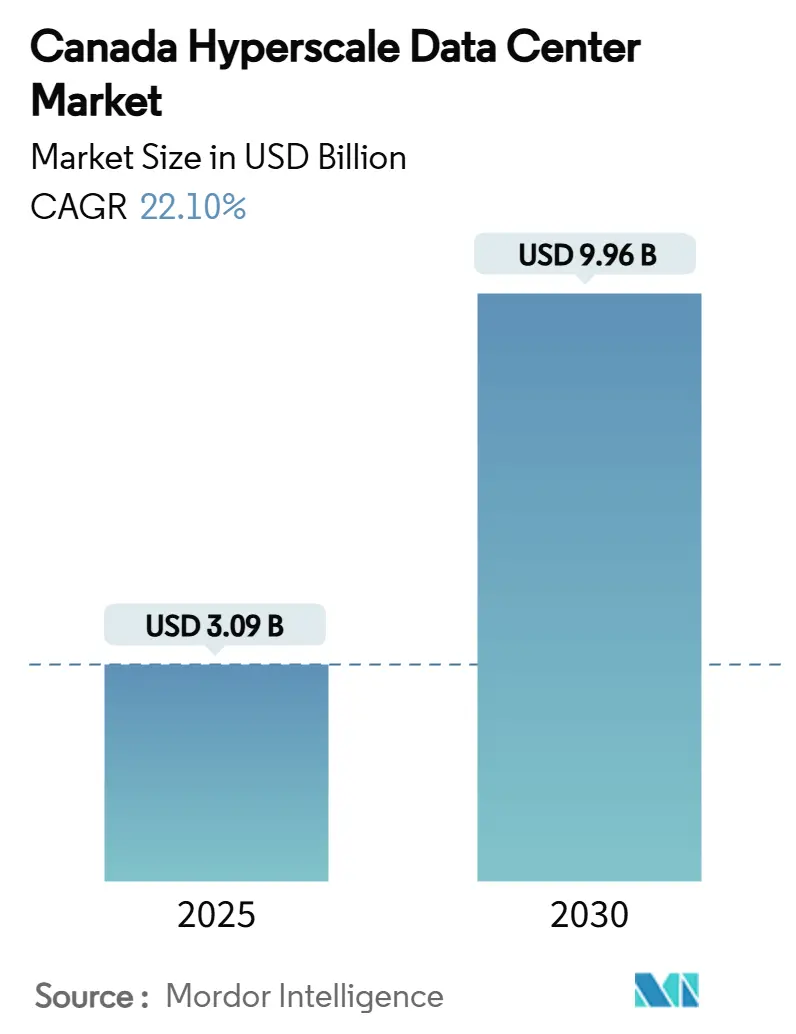
Canada Hyperscale Data Center Market Analysis by Mordor Intelligence
The Canada hyperscale data center market size will reach USD 3.09 billion in 2025 and is forecast to climb to USD 9.96 billion by 2031, expanding at a 22.10% CAGR over the period while installed IT load scales from 2.356 thousand MW to 3.232thousand MW. Accelerated AI training clusters, aggressive renewable-power incentives and federal data-sovereignty rules underpin this outsized growth. Operators are redesigning facilities around >50 kW GPU racks, which boosts power density faster than overall capacity additions. Hyperscale self-builds dominate cap-ex today yet the colocation model is quickly gaining traction as U.S. cloud giants seek low-carbon grid access without shouldering Canadian permitting risk. At the same time, provincial utilities package long-term hydro and wind contracts to secure anchor tenants, supporting fresh opportunities for local construction and equipment vendors.
Key Report Takeaways
- By data center type, hyperscale self-builds led with 62% of the Canada hyperscale data center market share in 2024, while hyperscaler colocation is projected to expand at a 22.5% CAGR to 2031.
- By component, IT infrastructure accounted for 42% of the Canada hyperscale data center market size in 2024; liquid-cooling systems are advancing at a 22.1% CAGR through 2031.
- By tier standard, Tier III captured 73% revenue in 2024 and Tier IV is forecast to post a 23.3% CAGR to 2031.
- By end-user industry, cloud and IT controlled 49% of the Canada hyperscale data center market size in 2024, whereas AI cloud providers record the quickest rise at 22.8% CAGR to 2031.
- By data center size, massive facilities commanded 41% of the Canada hyperscale data center market share during 2024; the mega greater than 60 MW category is expected to grow at a 24% CAGR through 2031.
Canada Hyperscale Data Center Market Trends and Insights
Drivers Impact Analysis
| DRIVER | (~) % IMPACT ON CAGR FORECAST | GEOGRAPHIC RELEVANCE | IMPACT TIMELINE |
|---|---|---|---|
| Soaring cloud-AI training clusters (less than 50 kW racks, Montréal and Calgary) | 6.2% | Quebec, Alberta | Medium term (2-4 years) |
| Rapid build-to-suit demand from U.S. hyperscalers seeking low-carbon grid access | 5.8% | Quebec, British Columbia, Alberta | Short term (≤ 2 years) |
| Government green-energy incentives (Hydro-Québec, Alberta renewables PPAs) | 4.1% | Quebec, Alberta | Long term (≥ 4 years) |
| Record CDN-streaming and gaming traffic densifying Toronto edge nodes | 3.3% | Ontario | Short term (≤ 2 years) |
| GenAI inference campuses adopting liquid/immersion cooling | 2.1% | Global | Medium term (2-4 years) |
| First-mover SMR-powered data-center pilots at nuclear sites | 0.7% | Ontario | Long term (≥ 4 years) |
| Source: Mordor Intelligence | |||
Soaring cloud-AI training clusters (less than 50 kW racks)
Québec and Alberta each host campuses engineered for multi-petaflop jobs, such as QScale’s 142 MW Q01 site that exploits low-cost hydroelectricity to keep PUE below 1.15.[1]QScale, “Q01 Campus,” qscale.com These clusters pull in ancillary GPU design, networking and cooling vendors, reshaping local supply chains toward AI-first architectures.
Rapid build-to-suit demand from U.S. hyperscalers
AWS, Microsoft and Meta accelerate Canadian expansion to satisfy data-residency statutes and renewable-energy quotas, signing multi-decade PPAs and asking local developers to fast-track 30-60 MW halls.[2] Amazon Web Services, “AWS Economic Impact Study,” amazonaws.com
Government green-energy incentives
Hydro-Québec offers power at 4.5 US cents/kWh and tailored grid-interconnect studies, while Alberta approves indexed renewable credits for loads above 10 MW, cutting opex and enabling long visibility on energy supply.[3]IT Brief, “LF Energy welcomes Hydro-Quebec as strategic member,” itbrief.news
CDN-streaming and gaming traffic densifying edge nodes
5G standalone cores from Rogers and Bell push compute closer to Toronto subscribers, spawning micro-halls under 5 MW that feed latency-sensitive video and gaming traffic.
Restraints Impact Analysis
| RESTRAINTS | (~) % IMPACT ON CAGR FORECAST | GEOGRAPHIC RELEVANCE | IMPACT TIMELINE |
|---|---|---|---|
| Lengthy power-interconnect permitting (less than 24 months) | -3.8% | Alberta, Ontario | Medium term (2-4 years) |
| Acute skilled-labour shortages for large-scale MEP builds | -2.9% | National | Short term (≤2 years) |
| Proposed federal clean-electricity regulations raising cap-ex | -1.7% | National | Long term (≥4 years) |
| Provincial water-use moratoria affecting evaporative cooling | -1.2% | British Columbia, Alberta | Medium term (2-4 years) |
| Source: Mordor Intelligence | |||
Lengthy power-interconnect permitting (less than 24 months)
Alberta’s phased connection ceiling of 1,200 MW for new large loads and Ontario’s multi-agency reviews stretch timelines, forcing developers to build excess battery reserve or hunt secondary substations.
Acute skilled-labour shortages for large-scale MEP builds
Vacancies topping 80,000 in Canada’s construction trades delay mechanical-electrical-plumbing fit-outs, inflate wages and constrain schedule certainty for 70 MW-plus campuses.
Segment Analysis
By Data Center Type: Self-Build Dominance Faces Colocation Challenge
Self-builds controlled 62% revenue in 2024, a reflection of hyperscalers’ preference for bespoke designs and in-house operational playbooks; nevertheless, the Canada hyperscale data center market is tilting toward specialist colocation as its 22.5% CAGR outstrips overall expansion. Colocation eases capital intensity and permits rapid entry into power-rich provinces where local partners manage land and grid negotiations.
Colocation’s ascent is accelerated by flexible hall leasing models, sovereign-cloud stipulations and sustainability scorecards that reward shared facilities using district heat-re-use schemes. The shift enables mid-tier customers to tap the Canada hyperscale data center market without full-scale builds, encouraging experimentation with AI inference workloads.
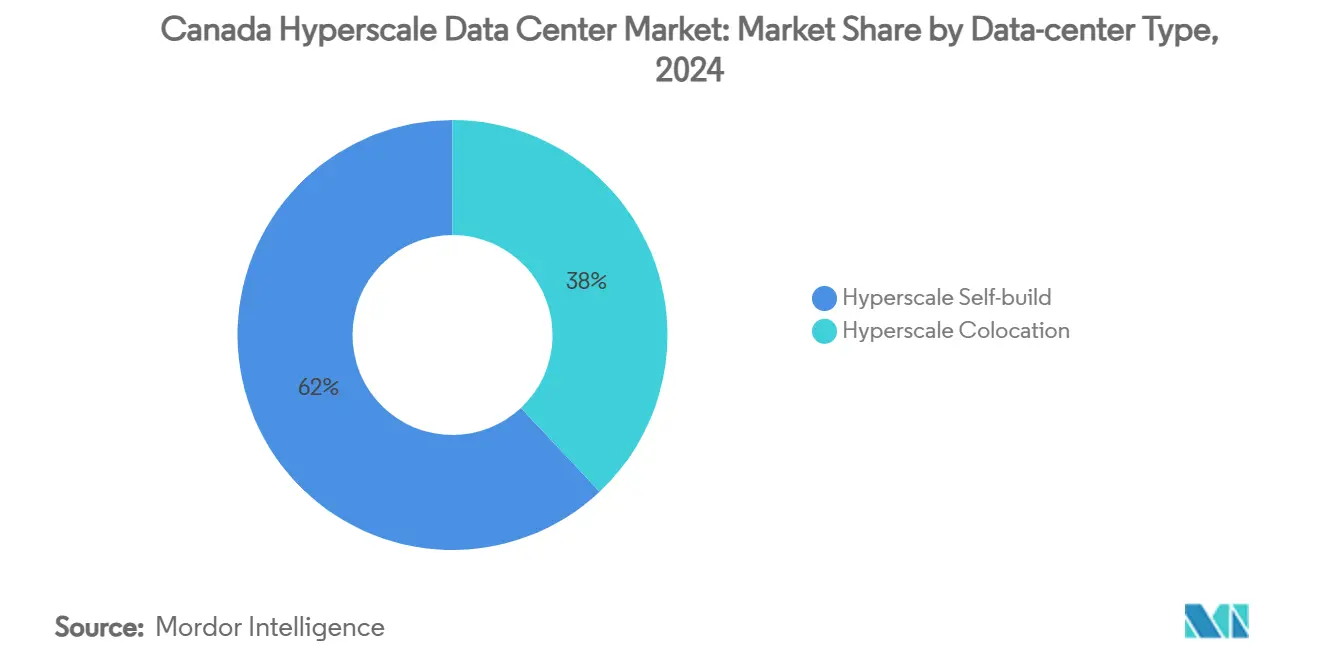
By Component: IT Infrastructure Leadership Challenged by Cooling Innovation
IT infrastructure drew 42% of 2024 outlays, but liquid cooling is poised for the fastest lift at 22.1% CAGR as rack densities double inside new AI pods. The Canada hyperscale data center market size allocated to immersion and cold-plate systems will cross the USD 900 million mark by 2031. Facility owners gain 30-50% space savings, cut fan power and meet utility water-use limits.
Electrical upgrades trail this thermal race: busways and switchgear now spec for peak loads >300 W/ft². Procurement strategies increasingly bundle transformers with harmonic filters to tame GPU-driven inrush, reflecting the evolving component stack inside the Canada hyperscale data center industry.
By Tier Standard: Tier III Reliability Meets Tier IV AI Demands
Tier III remains the mainstream choice with 73% revenue, balancing uptime and cost. Yet AI clusters prone to job-restart penalties propel Tier IV to a projected 23.3% CAGR. Operators are retrofitting Tier III sites with section-level 2N power to edge toward Tier IV without wholesale rebuilds, preserving sunk assets inside the Canada hyperscale data center market.
At campus scale, modular redundancy prevails: separate medium-voltage feeds, triple water loops and dual utility substations slash the statistical likelihood of synchronous failure, a design increasingly sought by GPU farm tenants.
By End-User Industry: Cloud Dominance Yields to AI Specialization
Cloud and IT workloads generated 49% value in 2024, yet AI cloud providers will post top-line gains of 22.8% CAGR, mirroring enterprise migration toward model training, vector search and inference engines. Banks move fraud analytics onto private AI fabrics, and federal agencies consolidate 300+ heritage rooms into two enterprise-class nodes, boosting the Canada hyperscale data center market share captured by public-sector tenants.
Telecom operators convert central offices into micro-data centers, supplying 5G edge compute for XR and cloud gaming. Manufacturing follows with predictive-maintenance AI requiring sub-50 ms latency to floor sensors, intensifying local demand.
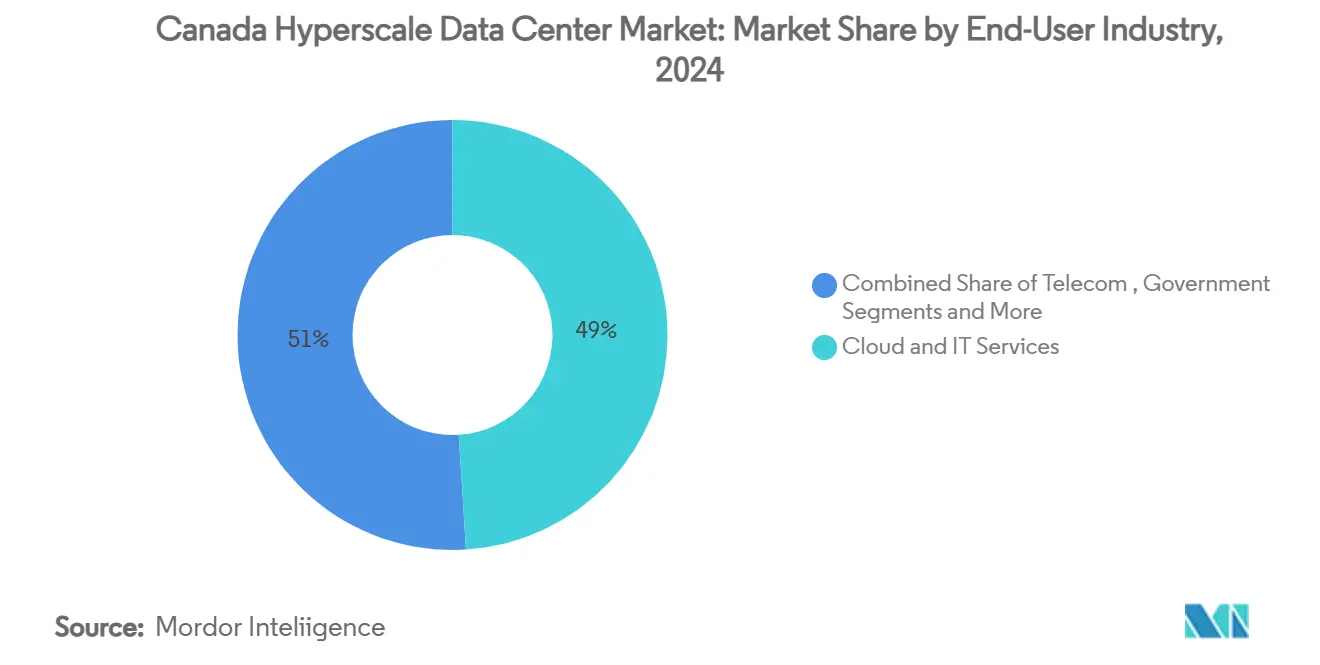
Note: Segment shares of all individual segments available upon report purchase
By Data Center Size: Massive Facilities Lead, Mega Projects Accelerate
Massive 25-60 MW halls represented 41% revenue in 2024, offering volume efficiency without the land commitments of mega campuses. However mega greater than 60 MW projects will post a 24% CAGR as single-tenant AI superclusters adopt 100 MW blocks. Bell Canada’s 500 MW AI Fabric anchors this shift, reinforcing the Canada hyperscale data center market size growth at the top end.
Smaller ≤25 MW builds retain strategic importance for edge aggregation at provincial capitals, ensuring balanced footprint distribution across the national fiber spine.
Geography Analysis
Ontario keeps leadership on account of Toronto’s financial core, dense fiber backbones and resilient multi-cloud interconnection hubs. Nevertheless, 2024 flooding that disrupted cooling at 151 Front Street urged operators to adopt sealed-loop or liquid designs, reinforcing cap-ex on resilience.
Québec is the velocity champion powered by Hydro-Québec’s 4.5 US cents/kWh tariff, 99% renewable grid and waste-heat valorization. QScale’s 142 MW Q01 campus exemplifies circular-economy synergies by piping exhaust heat to horticulture, helping the province court European AI tenants.
Alberta and British Columbia plot catch-up curves. Alberta’s phased-load program balances the region’s USD 100 billion AI ambition with grid security, while British Columbia hosts Bell’s sovereign AI campus leveraging low-carbon hydro. Manitoba, Saskatchewan and Atlantic Canada form emerging micro-regions fortified by federal fiber grants that cut rural-latency penalties for edge initiatives.
Competitive Landscape
Market concentration is moderate as incumbents Cologix, eStruxture and Digital Realty vie against hyperscale self-builds by AWS and Microsoft. Telecommunications players Bell and Telus pivot toward integrated AI infrastructure offerings that mix dark fiber, 5G and data-center leasing, heightening rivalry inside the Canada hyperscale data center market.
Specialist entrants pursue workload niches: QScale courts HPC and AI, CoreWeave brings GPU-rent models, and Vertiv partners with campus operators for wooden-module sustainability pilots. Differentiation hinges on renewable-energy intensity, fault-tolerant design and liquids-first thermal schemes rather than square-foot pricing alone.
Equipment alliances shape the field. Nvidia distributes DGX clusters directly to sovereign clouds, Schneider Electric bundles SMR-ready switchgear and ABB co-develops microgrid controllers with Hydro-Québec, embedding vendor influence deep into procurement cycles and capping competitive moats.
Canada Hyperscale Data Center Industry Leaders
-
Amazon Web Services, Inc. (AWS)
-
Microsoft Corporation
-
Alphabet Inc. (Google)
-
Digital Realty Trust Inc.
-
Cologix Inc.
- *Disclaimer: Major Players sorted in no particular order
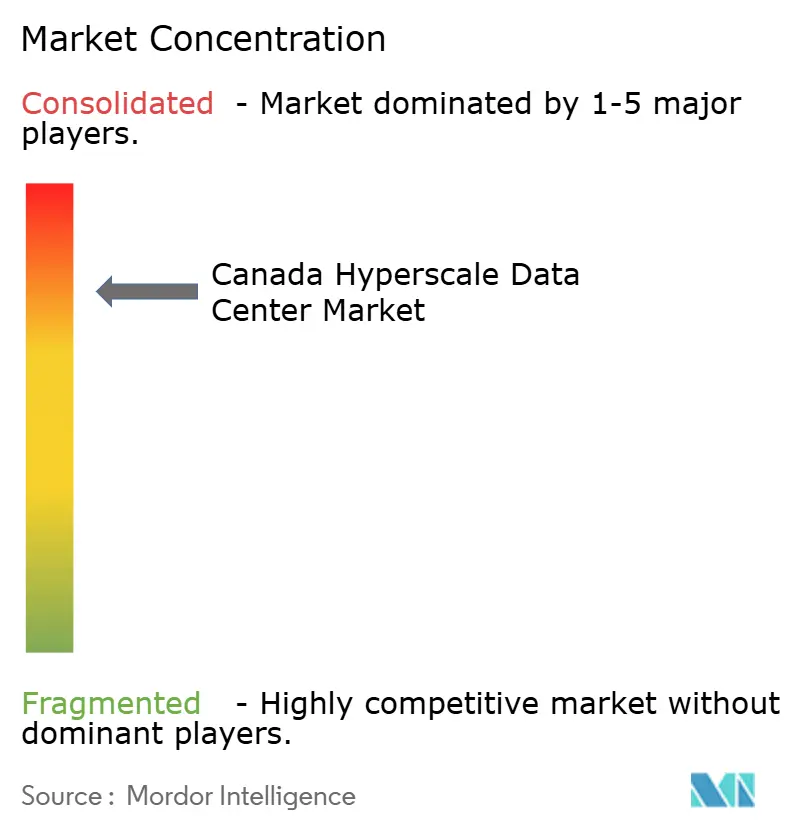
Recent Industry Developments
- July 2025: Meta to invest hundreds of billions in multi-gigawatt AI data centers, citing potential Canada builds.
- June 2025: Bell Canada launches 500 MW hydro-powered AI Fabric across six sites.
- May 2025: Equinix posts USD 2.225 billion Q1 revenue, lifts full-year guidance, highlights AI demand.
- April 2025: eStruxture breaks ground on 90 MW CAL-3 Calgary site set for H2 2026.
Research Methodology Framework and Report Scope
Market Definitions and Key Coverage
Our study defines the Canadian hyperscale data-center market as revenue generated inside purpose-built or leased halls that individually exceed 25 MW of critical IT load and host thousands of servers for cloud, AI, and internet-platform workloads, whether self-built by the operator or contracted as hyperscale colocation.
Scope exclusions include edge sites below 5 MW, enterprise on-premise rooms, and legacy carrier hotels, which are not counted.
Segmentation Overview
- By Data Center Type
- Hyperscale Self-build
- Hyperscale Colocation
- By Component
- IT Infrastructure
- Server Infrastructure
- Storage Infrastructure
- Network Infrastructure
- Electrical Infrastructure
- Power Distribution Units
- Transfer Switches and Switchgears
- UPS Systems
- Generators
- Other Electrical Infrastructure
- Mechanical Infrastructure
- Cooling Systems
- Racks
- Other Mechanical Infrastructure
- General Construction
- Core and Shell Development
- Installation and Commissioning Services
- Design Engineering
- Fire Detection, Suppression and Physical Security
- DCIM / BMS Solutions
- IT Infrastructure
- By Tier Standard
- Tier III
- Tier IV
- By End-User Industry
- Cloud and IT
- Telecom
- Media and Entertainment
- Government
- BFSI
- Manufacturing
- E-Commerce
- Other End Users
- By Data Center Size
- Large ( Less than or equal to 25 MW)
- Massive (Greater than 25 MW and Less than equal to 60 MW)
- Mega (Greater than 60 MW)
Detailed Research Methodology and Data Validation
Primary Research
Mordor analysts spoke with design engineers at major hyperscale builders in Ontario and Québec, power-utility planners, liquid-cooling OEM specialists, and global cloud-procurement teams. Their insights filled deployment timing gaps, verified average build costs, and fine-tuned our utilization ramps across different rack density tiers.
Desk Research
We began with national datasets such as Statistics Canada electricity-use tables, Innovation, Science & Economic Development Canada spectrum filings, Canada Energy Regulator power-pipeline reports, and Hydro-Québec tariff schedules, which indicate where low-carbon megawatt hours are available. Trade groups, including the Uptime Institute and the Open Compute Project, provided density benchmarks and adoption curves, while company filings retrieved from D&B Hoovers and news flows screened through Dow Jones Factiva helped size operator CAPEX and new-build announcements. These sources establish the factual backbone of market demand, supply additions, and pricing.
Because public information is still patchy, the desk-research list above is illustrative, not exhaustive, and many additional records were reviewed for validation and clarification.
Market-Sizing & Forecasting
A top-down reconstruction of installed and announced megawatts by province formed the starting point, complemented by bottom-up sampling of facility-level ASP × capacity to cross-check totals. Key variables, like pipeline MW filings, average build cost per MW, rack density migration above 50 kW, renewable power price spreads, and GPU adoption rates, drive the multivariate regression forecast. Where capacity details were missing, we applied conservative fill rates based on historical Québec and GTA commissioning patterns before triangulating them with channel checks.
Data Validation & Update Cycle
Every model pass runs variance screens against independent capacity trackers and utility interconnection logs; anomalies trigger peer review and follow-up calls. Reports refresh annually, with mid-cycle updates when material project announcements move the baseline.
Why Mordor's Canada Hyperscale Data Center Baseline Commands Reliability
Published estimates diverge because firms differ on what counts as hyperscale revenue, how they convert capital investment to market value, and how often they refresh models.
Key gap drivers include scope dilution, which involves mixing colocation or enterprise rooms, reliance on regional ratios instead of facility data, currency conversion timing, and inconsistent treatment of hardware spend versus service revenue. Mordor's disciplined facility screen and annual refresh minimize these distortions.
Benchmark comparison
| Market Size | Anonymized source | Primary gap driver |
|---|---|---|
| USD 3.09 B (2025) | Mordor Intelligence | |
| USD 5.44 B (2024) | Regional Consultancy A | Totals capital investment across all data-center types, not revenue. |
| USD 10.26 B (2023) | Global Consultancy B | Uses broad data-center revenue and regional scaling, lacks facility counts. |
| USD 45.53 B (2024) | Trade Journal C | Adds hardware and services for every facility class, no hyperscale filter. |
These comparisons show that when scope is tightened around true hyperscale halls and validated through on-the-ground capacity checks, our 2025 baseline gives decision-makers a balanced, transparent figure they can trace back to clear variables and repeatable steps.
Key Questions Answered in the Report
What is the projected value of the Canada hyperscale data center market by 2031?
The market is expected to reach USD 9.96 billion by 2031, up from USD 3.09 billion in 2025.
Which Canadian province offers the lowest electricity rate for hyperscale operators?
Québec leads with hydro-power tariffs near 4.5 US cents/kWh, drawing numerous self-build and colocation projects.
Why are liquid-cooling systems gaining popularity in Canada hyperscale data centers?
AI racks exceeding 50 kW produce heat loads air systems cannot handle efficiently; liquid cooling cuts fan power and meets strict provincial water-use limits.
Why are liquid-cooling systems gaining popularity in Canada hyperscale data centers?
AI racks exceeding 50 kW produce heat loads air systems cannot handle efficiently; liquid cooling cuts fan power and meets strict provincial water-use limits.
How fast is the hyperscaler colocation segment growing?
Hyperscaler colocation is forecast to expand at a 22.5% CAGR between 2025 and 2031, outperforming the broader market.
What is the biggest hurdle for new mega facilities in Canada?
Extended power-interconnect permitting—often longer than 24 months—creates the most significant timeline risk for projects larger than 75 MW.
Page last updated on:
